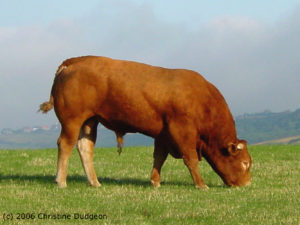Buying A Breeding Bull
15 February 2017Buying a good breeding bull is a skill like any others in farming. But no matter how good your choice if you handle him badly once you get him home you wont get the best from your investment.
You took time to study the bulls on offer and time to decide. But do not forget the bull will also need time to adjust to his new surroundings. At a time when many farmers are leaving purchasing decisions until cash flow is better it is worth remembering a bull needs 2 to 3 months after sale to adjust properly and get into condition ready to go out with the females.
Soon as he is purchased It is important to wash him down and flush out the soap used at the sales. Leaving this on can cause skin irritation and has at times led to hair loss.
Feeding
Remember sudden dietary shocks can cause fertility issues and unsettle a bull that is a why It is sometimes remarked that after a few days a new bull seems very restless and has temperament issues. He simply needs time to settle in. Do not suddenly put him on a restricted diet as it is not good to have sudden changes in quantity and type of feed. If possible it is worthwhile asking the seller for a bag of the feed, or what is left, that the bull was fed prior to sale. Indeed it would be good if in the future it became common practice to have feed available to the buyer. It could be worthwhile to purchase or make up a good energy concentrate feed.
Feed him reasonably well initially to settle him and then slowly start to reduce the level of concentrates over a period of time. He will not be used to just forage so make sure that not only is the correct energy and protein fed but there are also the right levels of vitamins and minerals.
Quarantine
Also bulls brought to sales are often group housed from weaning and not used to isolation. It is bad practice to simply purchase the bull and put him in an area where he has little contact with what is going on roundabout him or confined in a dark pens. Yes newly bought stock must be quarantined, but bulls need to see activity, especially as he has had a lot of close contact prior to sale.
Spend time with your investment. Allow him to have exercise, which he is used to when being reared. If he was halter trained then it is ideal to continue with this and as soon as he is out of quarantine close contact with other livestock is advised.
Exercise
It is important to avoid injury when he is put out to work. Exercise in a small paddock, with some company to get his locomotion and muscles working is advisable preparation for serving the cows. Imagine Usain Bolt sitting on his behind for 3 months before running 100 metres. He would pull every muscle in his body! So it is ideal to keep water and feed at opposite ends of the paddock to encourage movement.
Pre-Breeding Examination
Before he starts to work it is important have a veterinary pre-breeding examination to check he is physically normal and has adequate semen quality. A number of commercial men are now testing bulls with a couple of cows pre-season to see if he settles them and gains confidence prior to main bulling period. A young bull should be educated and serve his first female under supervision on a non slip surface. Observe him closely to check for normal service behaviour and absence of any penile injury or lesions like warts.
One question I am often asked is how many cows should he go to when ready? Opinions vary from 10 to 20 females for a young bull (many believe that for every month of age he should have 1 cow, so 16 months = 16 females.) Monitor returns to service and if you are getting more than 50% returns it is suspicious. So always know what your insurance covers.
Parasite Control
Do not forget parasite control. Dose for worms and fluke after the grazing period as many young bulls will have little or no immunity. Do not get rid of the old boy either. The young gun has yet to prove himself and it is always correct to have back-up on farm. Too often we lack bull power on farms and work with little, if any, spare.
Post Mating Care
Finally, after the young bull has been removed from the cows, he should then be put onto a growing ration as he still has significant growth and development to do. When this is not done it can have an impact on his longevity and capability.
For bulls that have lost a lot of condition, more than the 0.75 CS, then start the feeding earlier so that there is a longer time to replenish weight at a sensible weight gain and concentrate input. For large bulls that have lost a lot of weight then a standard 12 ME beef nut will not do. They require a higher energy nut (12.5 to 13 ME) and if large amounts are needed then it must be spread over 2 meals per day.
Gavin Hill, gavin.hill@sac.co.uk
Sign up to the FAS newsletter
Receive updates on news, events and publications from Scotland’s Farm Advisory Service

